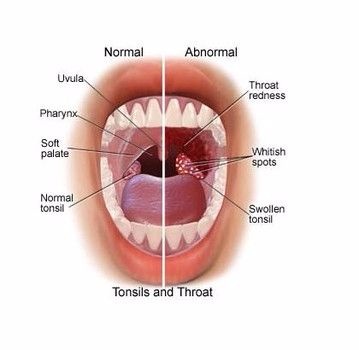 The average person swallows about 50 times per minute. How do you measure up? It’s okay if you have no idea, because most guys don’t gauge their gulps.
The average person swallows about 50 times per minute. How do you measure up? It’s okay if you have no idea, because most guys don’t gauge their gulps.
Unless you have a sore throat, that is. If so, you’re painfully aware of each and every time you need to push something down your thick, burning throat, even if it’s just something as simple as your own spit.
Throat symptoms are one of the most common reasons people go see their doctor, ranking above high blood pressure, back problems, and rashes, according to the National Ambulatory Medical Care Survey.
(You should also make an appointment if you’re guilty of these 5 Bad Excuses Why You Don’t See a Doctor.)
The symptoms of sore throat can be acute—they come on suddenly and last for several days—or chronic, meaning they persist for weeks or even months. In some cases, the symptoms can fluctuate over time, making you believe you’re over soreness only to have it keep coming back, says John Ingle, M.D., a laryngologist and assistant professor of otolaryngology at the University of Rochester Medical Center.

The causes of sore throat can be confusing—even to doctors. If you have symptoms that persist or are severe, make an appointment with your primary care doc or an ear, nose, and throat specialist, Dr. Ingle says. In the meantime, take a look at some of these common causes to see where your sore throat might fit in.
1. Colds
Upper respiratory infections caused by viruses—like the common cold—are the most typical cause of acute sore throat. Usually you’ll start out with an irritated throat or nasal congestion. Then other symptoms like coughing, sneezing, and runny nose can rear their heads later, says Dr. Ingle.
Some of these viruses can directly attack your throat, which can cause little ulcerations to form on the delicate lining of your pharynx, located by your tonsils.
This can trigger a burning sensation that continues even when you’re not using your throat, says Ibrahim Alava, M.D., an assistant professor in the department of otorhinolaryngology-head and neck surgery at the University of Texas Health Science Center at Houston Medical School.
Even if the virus isn’t gunning for your throat, you can still experience irritation due to coughing or throat clearing. In that case, your throat will usually just feel sore when you swallow.
Rest, fluids, and non-steroidal anti-inflammatory drugs (NSAIDs) can help you beat back your cold symptoms, and you should start to feel better in a few days.
2. Flu
Sore throat isn’t the hallmark symptom with the influenza virus, but it still can pop up in flu. As with a cold, coughing can irritate your throat and cause it to feel sore.
One difference, though, is a cold usually comes on gradually. The onset of flu tends to be much more dramatic.
“You can have sore throat with both, but what tips you off to flu is that it’s more severe,” says Dr. Ingle. “You may have body aches, higher fever, fatigue, and you just feel like you’re knocked off your rocker.”
If you think you have the flu—after all, The Flu Shot Isn’t As Effective This Year—make an appointment with your doc. He or she can prescribe antivirals like Tamiflu, which can reduce the duration of the illness.
3. Bacterial Infections
Sore throats caused by a bacterial infection—like strep throat or tonsillitis—can be severe. You’re probably most familiar with strep throat, which makes up only about 10 percent of acute sore throat complaints in adults.
Unlike with a cold, you won’t usually experience sneezing, congestion, or cough with strep throat. What you will have is a sore throat that starts quickly and can cause a whole lot of pain while swallowing. You may also have bad breath, fever, and swollen lymph nodes in your neck.
Make an appointment with your doc if you have severe symptoms or run a fever over 101 degrees Fahrenheit, says Dr. Ingle.
A physical exam may point to strep—your doc might notice pus on the back of your tonsils. That signals your white blood cells ramping up to fight off the bacteria, says Dr. Alava. (Trying to shove a mirror down your own throat isn’t going to be much help, though. People often think they find pus, but they’re tricked by tiny white stones on the tonsils or even food particles. So leave it to a pro.)
The diagnosis is often confirmed by a rapid strep test, which can be done right in the doc’s office. If it turns up positive for strep bugs, you’ll be given antibiotics. But don’t expect instant improvement.
“The antibiotic needs to build up to a certain dose in the bloodstream to kill the infection,” says Dr. Alava. “A good rule of thumb for that is 48 to 72 hours.”
4. Mononucleosis
Mononucleosis, or mono, is known as the kissing disease, because it’s transmitted through saliva. It’s caused by the Epstein-Barr virus, and is most common in younger guys.
Mono can be difficult to diagnose because it can come on quickly or gradually, says Dr. Ingle. Common symptoms include sore throat, fever, significant fatigue, and swollen neck and armpit glands. Its symptoms can fluctuate, and may last from several weeks to months. If that sounds like you, see a doctor so he or she can find out what’s going on.
Sometimes mono can seem very similar to strep throat. If your doc thinks it’s strep and gives you a certain antibiotic for it, you can actually break out in a pink, measles-like rash. So ask him or her to test your throat to be sure. (Plus, look out for these 5 Conditions You Shouldn't Take Antibiotics For.)
Mono can be confirmed with something called the monospot test, but there’s no treatment for the virus: “You need to wait it out and it’ll slowly get better,” says Dr. Alava.
If you’re having significant pain with your throat, though, your doctor might prescribe you a steroid. That’ll help reduce the inflammation and allow you to swallow more easily.
5. Allergies
The allergies known as hay fever—the sneezing, watery eyes, and runny nose that you get after breathing in things like pollen, dust, or dander—can cause throat discomfort.
Usually it feels scratchy or tickling more than an actual pain, says Dr. Ingle. And it tends to be worse during the season when your allergens are most prevalent.
Certain foods can also be a culprit, and the signs may be so subtle you might not even link them to what you’re eating. They include throat irritation, an itchy mouth, or stomach problems like cramping or diarrhea.
If you notice these symptoms following a meal—especially after chowing down on nuts, citrus fruits, grains, or dairy—you might want to ask your doc for an allergy test. Food allergies can pop up at any age, not just in kids.
6. Laryngopharyngeal Reflux
Laryngopharyngeal reflux, or LPR, is similar to gastroesophageal reflux disease (GERD), except that it affects the throat. It’s known as “silent reflux,” because it often doesn’t cause the typical symptoms you’d expect, like heartburn or sour stomach.
In LPR, acids or digestive juices travel up from the stomach, through the esophagus, and to the throat or voice box, where they irritate the delicate tissue. Your stomach and esophagus have protective mechanisms that help neutralize the acids, but your throat is out of luck.
“It’s more sensitive,” explains Dr. Ingle. “Even small amounts making it up to the throat can really cause a lot of irritation.”
As a result, you can experience sore throat or a hoarse voice, both of which are often worse in the morning. You can also have a dry cough, a constant need to clear your throat, or a feeling that you have a lump or piece of food in your throat. And these symptoms can fluctuate over time. (Is Your Cough Something Serious? Find out some other reasons why you’re hacking.)
If your doc thinks you might have LPR, he may do tests to check the pH or the amount of digestive enzymes in your throat. You can be treated with antacids or stomach acid reducers. Eating a low-fat, less-spicy diet and avoiding alcohol and caffeine can help, too.
7. Dry Air
Dry winter air can wreak havoc on your throat. Forced-air heating strips a lot of the moisture out of the air, which can make it more irritating when it’s breathed in.
If you’re a mouth-breather—whether it’s due to nasal congestion or if your mouth simply flaps opens while you sleep—you’re at an even greater risk. That’s because your nose acts as a humidifier, imparting moisture to the air you take in before sending it down your throat and into your lungs.
“If you aren’t breathing through your nose, the dry air you’re taking in through your mouth tends to irritate the throat and dry it out even more,” says Dr. Ingle.
That causes a rough, scratchy throat, especially when you wake up. Fix it by beefing up your hydration: Drinking 60 to 80 ounces of water a day can help the linings of your mouth and throat stay moist as you sleep.
Plugging a humidifier into your bedroom can also help. But if you still show symptoms, make an appointment with your doctor—you may have sleep apnea.
8. Muscle Strain
You’ve probably lost your voice once or twice after screaming at the hapless refs during a football game. But you can also experience throat pain simply by using your throat muscles the wrong way.
This is more common in people who begin new jobs that require them to speak in a different way—say, you’re now responsible for giving frequent presentations—or in those who must use their voices often during the day, like teachers or performers.
What happens is you develop a way of speaking that ends up using too many muscles or extra muscles to produce the sound. As a result, you can develop chronic throat pain.
Muscle strain is usually diagnosed by a voice doctor or a vocologist. But your doc will want to exclude other more serious causes of throat pain before arriving at that finding. You can usually treat it with voice therapy.
9. Throat Tumors
You can develop cancer in parts of your upper throat, lower throat, or your voice box. Guys in their 40s can be diagnosed, but it’s much more common among men in their 50s, 60s, and 70s. It’s also usually related to smoking or drinking.
Causes for concern include persistent sore throat or throat pain, hoarseness that doesn’t improve in 2 weeks, difficulty swallowing food or saliva, weight loss, trouble breathing, or coughing up blood.
“Usually with a tumor or cancer, a sore throat starts out subtle and mild,” says Dr. Ingle. “It never goes away and gets worse over time.”
If you have those symptoms, it’s important to make an appointment with your doctor. Some primary care docs might want to send you for a CT scan, but it may be better to ask to see an ear, nose, and throat doctor first.
These docs can do something called a laryngoscopy, says Dr. Ingle. A flexible scope with a camera is passed through your nose, allowing the doctor to look at your throat or voice box for signs of cancer. It’s often more effective and less expensive than a CT scan—and it won’t expose you to that radiation.



